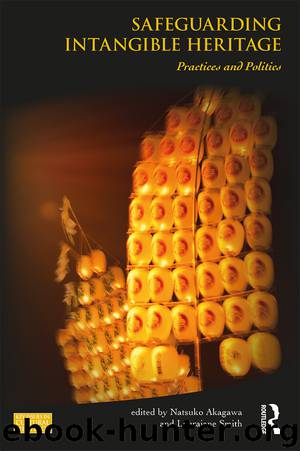Safeguarding Intangible Heritage by Natsuko Akagawa Laurajane Smith & Laurajane Smith

Author:Natsuko Akagawa,Laurajane Smith & Laurajane Smith
Language: eng
Format: epub
Publisher: Taylor & Francis (CAM)
Published: 2018-06-11T16:00:00+00:00
Assertion 2: international collaboration is achievable
Another significant element for absentees to the Convention is their lack of full participation within the international infrastructure that supports signatories to the Convention. The sovereign body of the Convention is the General Assembly that, in general, meets every two years. There is also an Intergovernmental Committee, which is made up of representatives from 24 individuals from States Parties that have signed the ICHC. These are elected for four-year terms at the General Assembly. This Committee has a range of significant functions relating to the promotion of the objectives of the Convention as well as the monitoring of its implementation. It submits directives to the General Assembly and plays a key role in strategic planning for ICH at international level. States that have not ratified the Convention cannot be key players in such strategic planning.
States that have not ratified the ICHC may well argue that they do not lose the benefits of this infrastructure as they can participate via NGOs that are accredited by UNESCO to discuss issues relating to ICH. Many absentees from the Convention have such NGOs. Québec has its Conseil Québécois du Patrimoine Vivant, while in Labrador there is a Heritage Foundation dealing with similar issues. In the UK, Museums Galleries Scotland (MGS) was formally accredited as an expert advisor in ICH to UNESCO in 2012, and has recently been joined by the UK-wide Heritage Craft Association.
The role of the NGOs in relation to the operation of the Convention is quite clear. They are welcome to contribute to discussion parts of the general meeting, and the NGO forum can present a written statement that is appended to the meeting agenda. The NGOs can influence the conceptual direction of the Convention and have an input into discussions on significant chapters. The NGOs do not work in isolation and regularly collaborate with one another. The impact of the NGO network has been considerably strengthened by recent activities designed to consolidate the voice of different NGOs in different countries. The first ICH forum conference was held in Barcelona in June 2015 and focused on a strategy towards a more formal organisation of the group. The first steering group of the NGOs was established in Namibia the following November, and terms of reference were subsequently drawn up. The NGOs are creating a secondary international layer of bureaucracy that can feed into the activities of UNESCO’s General Assembly and its core committees. However, these accredited NGOs are not ‘full members of the club’, and if they wish to put forward a change in policy they need a States Party that has ratified the Convention to make the case for them. Moreover, they are not formal members of the evaluation committee and are not part of the decision-making forum. Given the breadth of expertise in many of the absentees, we believe that the lack of core membership is a lost opportunity.
The networking opportunities afforded to member-states who have ratified the ICHC are impressive. More significantly, these networking opportunities
Download
This site does not store any files on its server. We only index and link to content provided by other sites. Please contact the content providers to delete copyright contents if any and email us, we'll remove relevant links or contents immediately.
| Africa | Americas |
| Arctic & Antarctica | Asia |
| Australia & Oceania | Europe |
| Middle East | Russia |
| United States | World |
| Ancient Civilizations | Military |
| Historical Study & Educational Resources |
Underground: A Human History of the Worlds Beneath Our Feet by Will Hunt(12024)
Sapiens by Yuval Noah Harari(5294)
Navigation and Map Reading by K Andrew(5111)
The Sympathizer by Viet Thanh Nguyen(4305)
Barron's AP Biology by Goldberg M.S. Deborah T(4097)
5 Steps to a 5 AP U.S. History, 2010-2011 Edition (5 Steps to a 5 on the Advanced Placement Examinations Series) by Armstrong Stephen(3689)
Three Women by Lisa Taddeo(3354)
Water by Ian Miller(3127)
The Comedians: Drunks, Thieves, Scoundrels, and the History of American Comedy by Nesteroff Kliph(3039)
Drugs Unlimited by Mike Power(2545)
A Short History of Drunkenness by Forsyth Mark(2233)
The House of Government by Slezkine Yuri(2159)
DarkMarket by Misha Glenny(2158)
And the Band Played On by Randy Shilts(2129)
The Library Book by Susan Orlean(2042)
Revived (Cat Patrick) by Cat Patrick(1963)
The Woman Who Smashed Codes by Jason Fagone(1929)
Birth by Tina Cassidy(1864)
The Absolutely True Diary of a Part-Time Indian by Sherman Alexie(1858)
